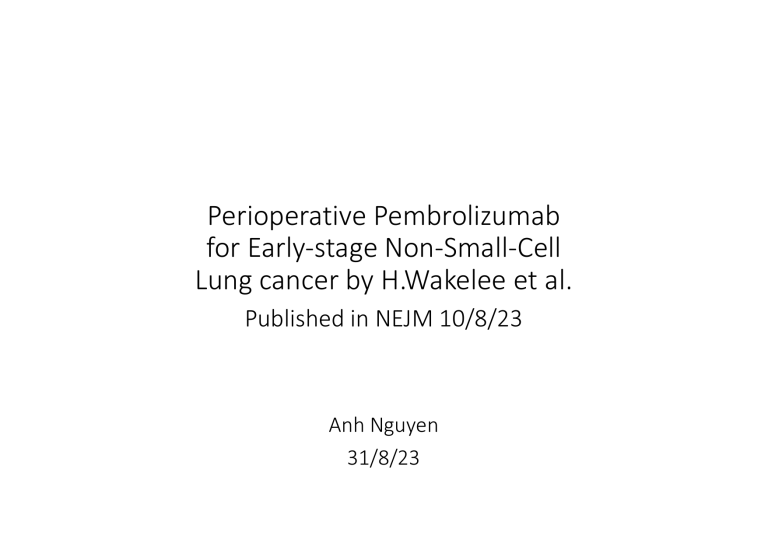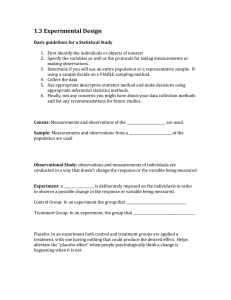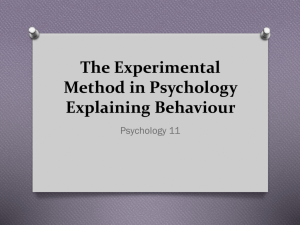
Perioperative Pembrolizumab for Early-stage Non-Small-Cell Lung cancer by H.Wakelee et al. Published in NEJM 10/8/23 Anh Nguyen 31/8/23 Lung cancer • Number 1 cause of cancer death in Australia and 5th most common cancer diagnosed (excluded non-melanoma cancers) • 14 500 people were diagnosed with lung cancer in 2022 • Broadly defined two types of lung cancer • Non-small cell lung cancer (85%) – adenocarcinoma,, squamous cell carcinoma, large-cell carcinoma • Small cell lung cancer (15) – more aggressive, rapid growth, earlier metastasis and poor prognosis Management of early stage resectable NSCLC • Chemotherapy, radiation therapy and surgery are mainstay treatment with aim of event/progression free survival, overall survival and potential cure surgical intervention of resectable cases • Treatment options dependent upon TMN staging, tumour’s characteristics and patient’s characteristics • However 5 year - overall survival is poor with approximately 20-30% mortality with NSCLC stage I, ~50% stage II, 60% stage IIIA • New development of immune check point inhibitors immunotherapy provides addition benefit with conventional chemotherapy in adjuvant and neoadjuvant setting PD-1/PD-L1 pathway • Program cell death protein 1 is a transmembrane protein that inhibits adaptive and innate immune responses when bound with PD-L1/PD-L2 • PD-1 is expressed on T/B cells, macrophages, dendritic cells and monocytes and is highly expressed on tumorspecific cytotoxic CD8+ T cells. • PD-L1 can be expressed by tumour cells as a adaptive mechanism avoid detection and destruction by the immune system • Thus therapeutic agents targeting the PD-1/PD-L1 pathway aims to induce anti-tumour CD8+ T cells activity and proliferation against tumour cells within the primary tumour as well as micrometastatic lesions and prevent recurrence • Pembrolizumab is a humanised antibody against PD-1 protein Study aim I. Evaluate perioperative neonadjuvant pembrolizumab in addition to cisplatin-based doublet chemotherapy followed by surgical resection and adjuvant pembrolizumab therapy would improve outcomes of event-free survival and overall survival compared to cisplatin-based doublet chemotherapy and surgery alone. Methods I. Double-blind, placebo-controlled, phase 3 multicentre clinical trial and stratified according to disease stage, PD-L1 tumour proportion score, squamous vs non-squamous, and geographic region of East Asia vs others. II. Enrolled patients at least 18 yo, with untreated, pathological confirmed stage II, IIIA, IIIB NSCLC that were deemed resectable after assessment, and ECOG PS 0-1 III. Neoadjuvant phase 4 cycles of 3 weekly IV pembrolizumab (200mg) or placebo plus cisplatin-gemcitabine (squamous tumours) or cisplatin-pemtrexed (nonsquamous tumours) followed by in-study surgery within 20 weeks after receiving first dose of neoadjuvant therapy. Adjuvant phase proceeded between 4-12 weeks after surgery and comprised of 200mg IV pembrolizumab or placebo every 3 weeks for up to 13 cycles. Radiotherapy was administered in selected circumstance. Methods Cont. I. Double-blind, placebo-controlled, phase 3 multicentre clinical trial and stratified according to disease stage, PD-L1 tumour proportion score, squamous vs non-squamous, and geographic region of East Asia vs others. II. Enrolled patients at least 18 yo, with untreated, pathological confirmed stage II, IIIA, IIIB NSCLC that were deemed resectable after assessment, and ECOG PS 0-1 III. Neoadjuvant phase 4 cycles of 3 weekly IV pembrolizumab (200mg) or placebo plus cisplatin-gemcitabine (squamous tumours) or cisplatin-pemetrexed (non-squamous tumours) followed by in-study surgery within 20 weeks after receiving first dose of neoadjuvant therapy. Adjuvant phase proceeded between 4-12 weeks after surgery and comprised of 200mg IV pembrolizumab or placebo every 3 weeks for up to 13 cycles. Radiotherapy was administered in selected circumstance. IV. Primary end-point were EFS, and OS. Secondary end points were major pathological response (<10% viable tumour cells in resected primary and LN), pathological complete response (absence of residual cancer) and adverse events and safety Results I. 1364 participants underwent screening and 797 were selected for the trial II. 397 were randomly screen into the pembrolizumab group III. 400 were randomly screened into the placebo group IV. median time from randomization to data-cutoff date was 25.2 months V. 396 participants in the pembrolizumab group received at least 1 dose of treatment with 82.1% underwent in-study surgery and 73.2% receiving at least one dose of adjuvant pembrolizumab VI. 399 participants in the placebo group received at least 1 dose of placebo and 79.4% underwent surgery and 66.9% received at least one dose of adjuvant placebo Results Cont. I. Median EFS and median OS were not reached in the pembrolizumab group compared to median EFS 17.0 months (95% CI, 14.3-22.0) and 45.5 months (95% CI, 42.0 to not reached). II. 24 months estimated EFS was 62.4% for pembrolizumab group vs 40.6% for placebo group. HR 0.58 (95% CI 0.46 to 0.72 P<0.001) III. 24 months OS estimated OS was 80.9% for pembrolizumab group vs 77.6% in placebo group. (P=0.02 was did not meet clinical significance criterion) IV. Major pathological response occurred in 120 (30%) in the pembrolizumab group and 44 (11%) in the placebo group with a 19.2% difference (P<0.0001). Pathological complete response occurred in 72 (18.1%) in the pembrolizumab group and 16 (4.0%) participants in the placebo group with a 14.2% difference (P<0.0001). V. Exploratory analysis showed EFS benefit independent of major pathology or pathological complete response. Safety I. 44.9% of the pembrolizumab group had treatment related adverse events of grade 3 or higher compared to 37.3 of those in the placebo group II. 4 (1%) participants in the pembrolizumab group died from treatment related adverse event (from immune-mediate lung disease, pneumonia, sudden cardiac death, atrial fibrillation) and 3 participants in the placebo group (0.8%) who died (from ACS, pneumonia and pulmonary haemorrhage) III. Treatment-related adverse events led to discontinuation of all trial treatment in 12.6 % in the pembrolizumab group and 5.3% in the placebo group IV. Potential immune-mediate adverse events and infusion incidents occurred in 25.3% of the pembrolizumab group and 10.5% in the placebo group with grade 3 or higher events occurring 5.8% for pembrolizumab vs 1.5% in placebo Discussion Discussion I. Well designed and powered study II. Demonstrated significance efficacy in overall EFS, pathological efficacy with MPR/CPR. III. Will have to wait for further data with regards to OS IV. Patient received ad-hoc neoadjuvant and adjuvant XRT that was not controlled for V. Study was sponsored by owner of the drug Merck, Sharp and Dohme with independent oversight VI. Does appeared to have increased rate of immune related and transfusion reaction but statistical significance was not mentioned/analysed VII. Study designed for the protocol of both neoadjuvant and adjuvant pembrolizumab simultaneous thus cannot interpret separate the benefit of pembrolizumab regiment for adjuvant/or neoadjuvant alone




